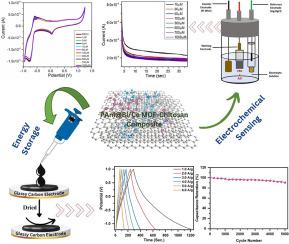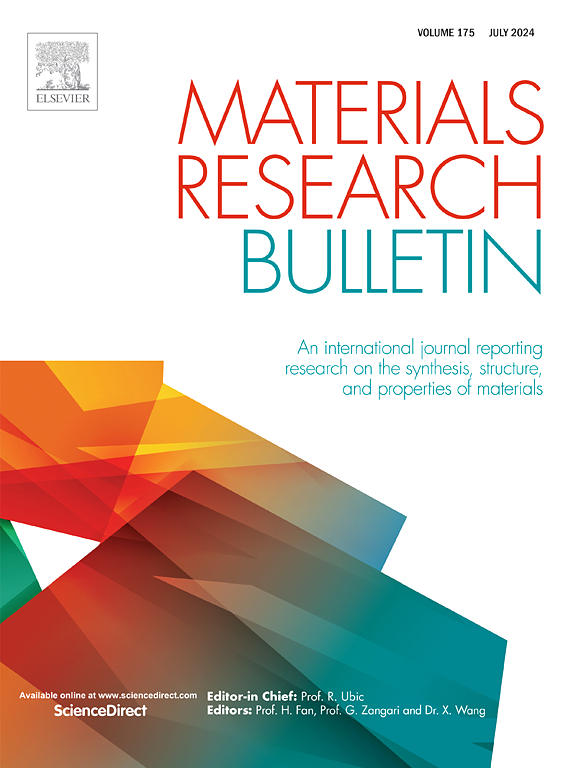Bifunctional PAni@Bi/Ce metal organic framework-Chitosan composite for electrochemical sensing and energy storage applications
IF 5.3
3区 材料科学
Q2 MATERIALS SCIENCE, MULTIDISCIPLINARY
引用次数: 0
Abstract
Tailoring pristine metal-organic frameworks (MOFs) offered a great opportunity in exploring electrochemical sensing and energy storage applications. This study presents a novel Polyaniline@Bi/Ce MOF-Chitosan composite synthesized via a solvothermal method and chemical oxidative polymerization. PXRD, FTIR, SEM, EDAX, and TEM characterization confirmed its structural and morphological properties. Electrochemical performance was evaluated using cyclic voltammetry (CV), electrochemical impedance spectroscopy (EIS), and electrochemical surface area (ECSA) analysis. The composite exhibited excellent electrocatalytic activity for detecting azithromycin and toluene with low detection limits and broad concentration ranges, demonstrated by voltammetry and amperometry. It showed significant stability for long term applications. Additionally, the material's energy storage capabilities were assessed through CV and galvanostatic charge-discharge (GCD) studies, revealing a specific capacitance of 415.32 F/g at 1.0 A g-1 and 90.48 % capacity retention after 5000 cycles at 6 A g-1. These findings highlight the Polyaniline@Bi/Ce MOF-Chitosan composite as a promising candidate for electrochemical sensing and energy storage applications.

用于电化学传感和储能应用的双功能 PAni@Bi/Ce 金属有机框架-壳聚糖复合材料
定制原始金属有机框架(MOFs)为探索电化学传感和储能应用提供了巨大的机遇。本研究介绍了一种新型聚苯胺@Bi/Ce MOF-壳聚糖复合材料,它是通过溶热法和化学氧化聚合法合成的。PXRD、FTIR、SEM、EDAX 和 TEM 表征证实了其结构和形态特性。使用循环伏安法(CV)、电化学阻抗光谱法(EIS)和电化学表面积分析法(ECSA)对其电化学性能进行了评估。伏安法和安培法显示,该复合材料在检测阿奇霉素和甲苯方面具有出色的电催化活性,检测限低,浓度范围广。它在长期应用中表现出明显的稳定性。此外,还通过 CV 和电静态充放电 (GCD) 研究评估了该材料的储能能力,结果显示,在 1.0 A g-1 的条件下,比电容为 415.32 F/g,在 6 A g-1 的条件下循环 5000 次后,电容保持率为 90.48%。这些研究结果表明,聚苯胺@铋/铈 MOF-壳聚糖复合材料是电化学传感和能量存储应用的理想候选材料。
本文章由计算机程序翻译,如有差异,请以英文原文为准。
求助全文
约1分钟内获得全文
求助全文
来源期刊

Materials Research Bulletin
工程技术-材料科学:综合
CiteScore
9.80
自引率
5.60%
发文量
372
审稿时长
42 days
期刊介绍:
Materials Research Bulletin is an international journal reporting high-impact research on processing-structure-property relationships in functional materials and nanomaterials with interesting electronic, magnetic, optical, thermal, mechanical or catalytic properties. Papers purely on thermodynamics or theoretical calculations (e.g., density functional theory) do not fall within the scope of the journal unless they also demonstrate a clear link to physical properties. Topics covered include functional materials (e.g., dielectrics, pyroelectrics, piezoelectrics, ferroelectrics, relaxors, thermoelectrics, etc.); electrochemistry and solid-state ionics (e.g., photovoltaics, batteries, sensors, and fuel cells); nanomaterials, graphene, and nanocomposites; luminescence and photocatalysis; crystal-structure and defect-structure analysis; novel electronics; non-crystalline solids; flexible electronics; protein-material interactions; and polymeric ion-exchange membranes.
 求助内容:
求助内容: 应助结果提醒方式:
应助结果提醒方式:


